Pure Foods' International Strategy: Netherlands Market Analysis Report
VerifiedAdded on 2022/11/25
|13
|2708
|431
Report
AI Summary
This report provides an in-depth analysis of Pure Foods' international business strategy, focusing on its potential expansion into the Netherlands market. It begins with an executive summary and an introduction to Pure Foods, a company specializing in organic and gluten-free products. The report then delves into an industry analysis and a SWOT analysis of Pure Foods. The core of the report involves a PESTLE analysis of the Netherlands market, evaluating political, economic, social, technological, legal, and environmental factors. The OLI framework is then applied to assess ownership, location, and internationalization strategies suitable for Pure Foods. The analysis considers various entry modes like exporting, franchising, and joint ventures. The report concludes by summarizing the key findings and recommendations for Pure Foods' internationalization efforts in the Netherlands, offering insights into market opportunities and potential challenges. The report references several academic sources to support its analysis.
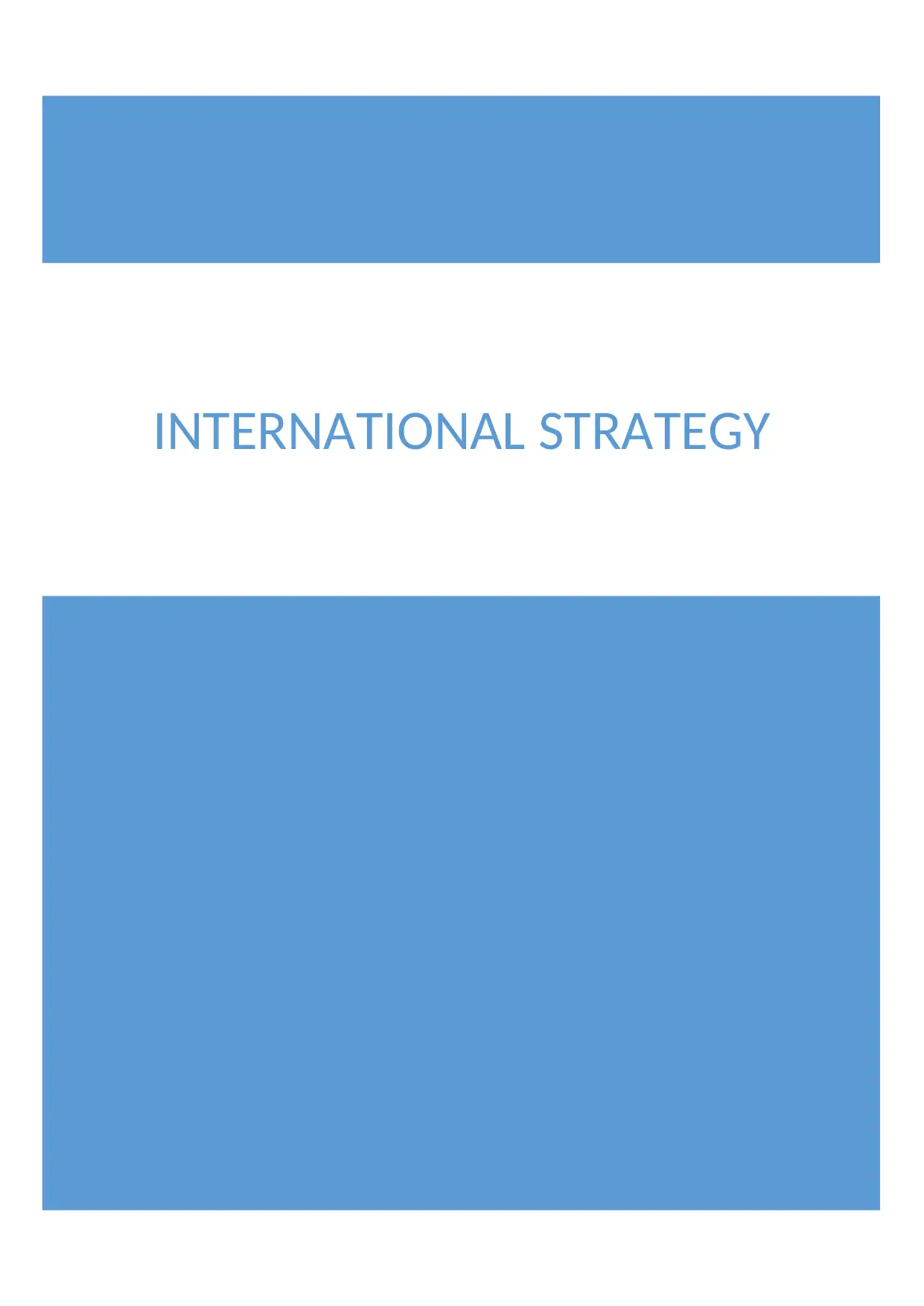
INTERNATIONAL STRATEGY
Secure Best Marks with AI Grader
Need help grading? Try our AI Grader for instant feedback on your assignments.
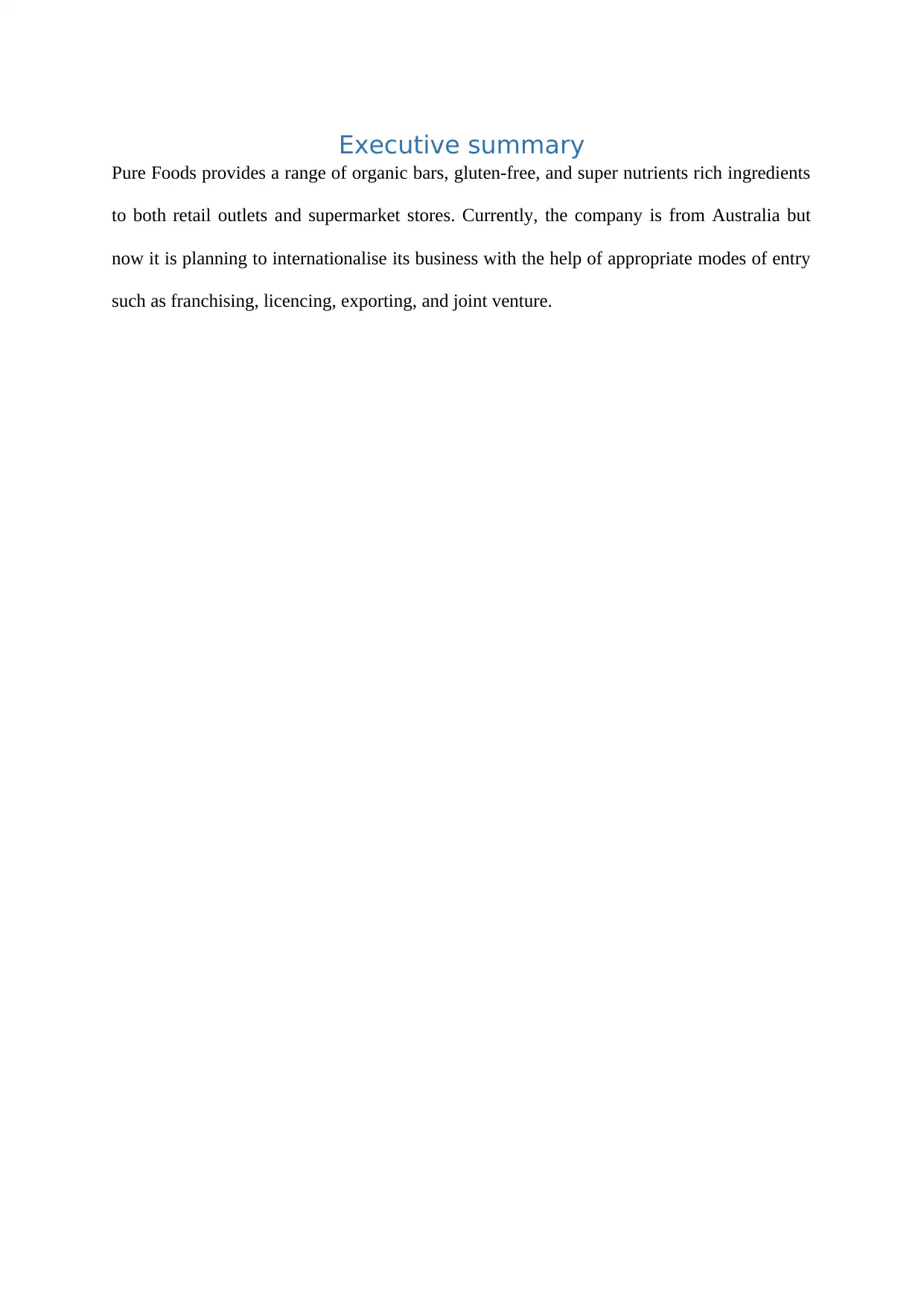
Executive summary
Pure Foods provides a range of organic bars, gluten-free, and super nutrients rich ingredients
to both retail outlets and supermarket stores. Currently, the company is from Australia but
now it is planning to internationalise its business with the help of appropriate modes of entry
such as franchising, licencing, exporting, and joint venture.
Pure Foods provides a range of organic bars, gluten-free, and super nutrients rich ingredients
to both retail outlets and supermarket stores. Currently, the company is from Australia but
now it is planning to internationalise its business with the help of appropriate modes of entry
such as franchising, licencing, exporting, and joint venture.
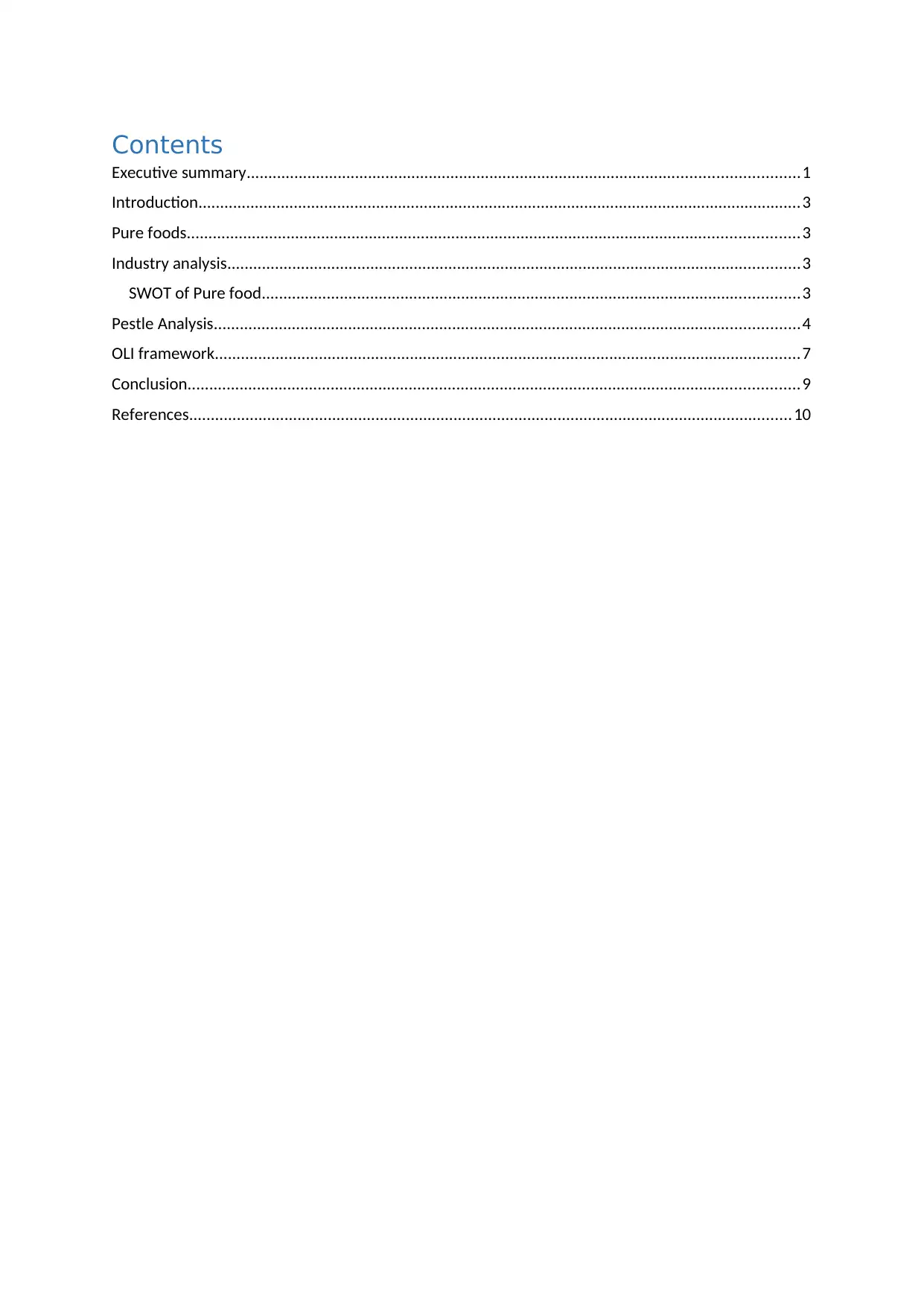
Contents
Executive summary...............................................................................................................................1
Introduction...........................................................................................................................................3
Pure foods.............................................................................................................................................3
Industry analysis....................................................................................................................................3
SWOT of Pure food............................................................................................................................3
Pestle Analysis.......................................................................................................................................4
OLI framework.......................................................................................................................................7
Conclusion.............................................................................................................................................9
References...........................................................................................................................................10
Executive summary...............................................................................................................................1
Introduction...........................................................................................................................................3
Pure foods.............................................................................................................................................3
Industry analysis....................................................................................................................................3
SWOT of Pure food............................................................................................................................3
Pestle Analysis.......................................................................................................................................4
OLI framework.......................................................................................................................................7
Conclusion.............................................................................................................................................9
References...........................................................................................................................................10
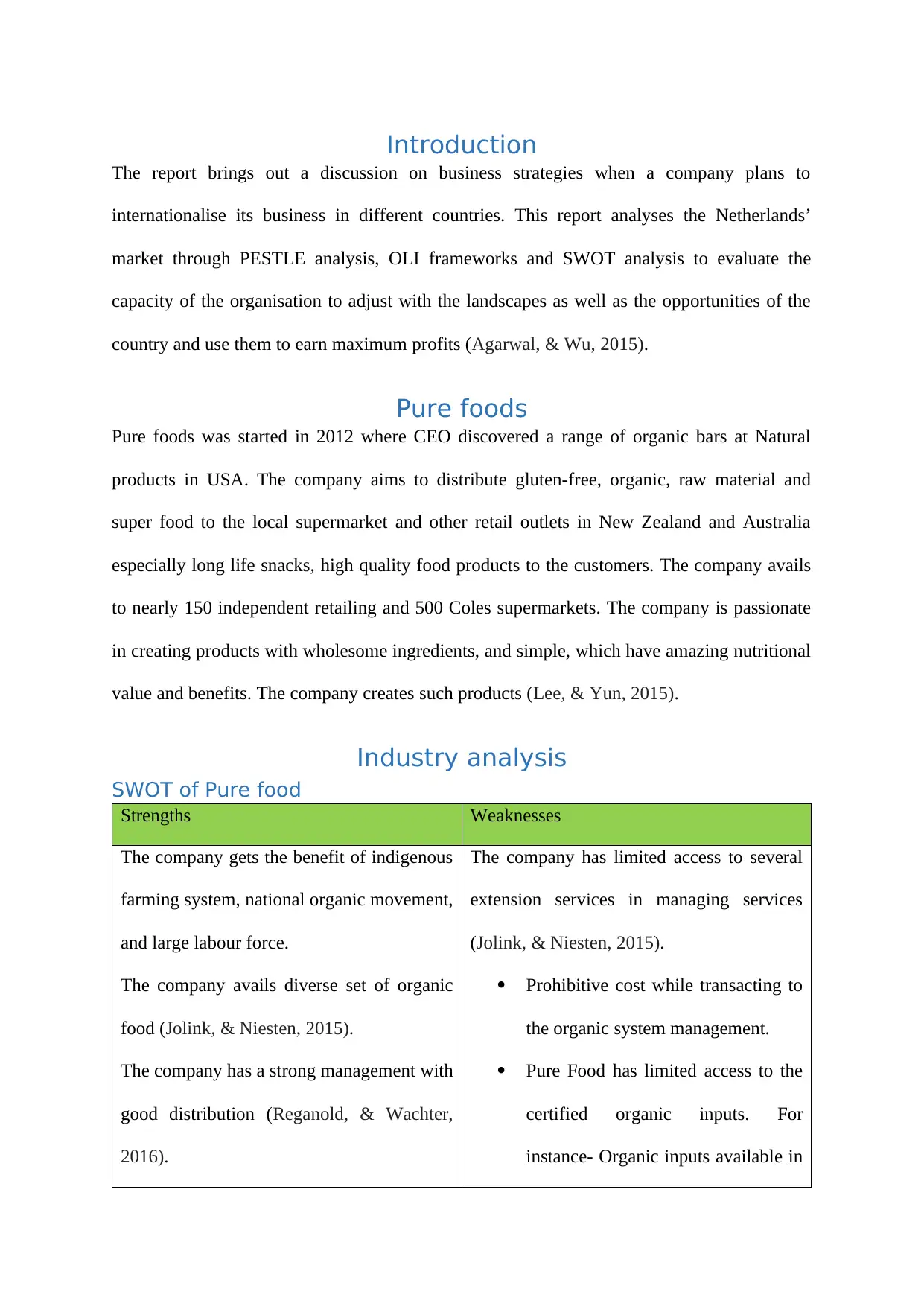
Introduction
The report brings out a discussion on business strategies when a company plans to
internationalise its business in different countries. This report analyses the Netherlands’
market through PESTLE analysis, OLI frameworks and SWOT analysis to evaluate the
capacity of the organisation to adjust with the landscapes as well as the opportunities of the
country and use them to earn maximum profits (Agarwal, & Wu, 2015).
Pure foods
Pure foods was started in 2012 where CEO discovered a range of organic bars at Natural
products in USA. The company aims to distribute gluten-free, organic, raw material and
super food to the local supermarket and other retail outlets in New Zealand and Australia
especially long life snacks, high quality food products to the customers. The company avails
to nearly 150 independent retailing and 500 Coles supermarkets. The company is passionate
in creating products with wholesome ingredients, and simple, which have amazing nutritional
value and benefits. The company creates such products (Lee, & Yun, 2015).
Industry analysis
SWOT of Pure food
Strengths Weaknesses
The company gets the benefit of indigenous
farming system, national organic movement,
and large labour force.
The company avails diverse set of organic
food (Jolink, & Niesten, 2015).
The company has a strong management with
good distribution (Reganold, & Wachter,
2016).
The company has limited access to several
extension services in managing services
(Jolink, & Niesten, 2015).
Prohibitive cost while transacting to
the organic system management.
Pure Food has limited access to the
certified organic inputs. For
instance- Organic inputs available in
The report brings out a discussion on business strategies when a company plans to
internationalise its business in different countries. This report analyses the Netherlands’
market through PESTLE analysis, OLI frameworks and SWOT analysis to evaluate the
capacity of the organisation to adjust with the landscapes as well as the opportunities of the
country and use them to earn maximum profits (Agarwal, & Wu, 2015).
Pure foods
Pure foods was started in 2012 where CEO discovered a range of organic bars at Natural
products in USA. The company aims to distribute gluten-free, organic, raw material and
super food to the local supermarket and other retail outlets in New Zealand and Australia
especially long life snacks, high quality food products to the customers. The company avails
to nearly 150 independent retailing and 500 Coles supermarkets. The company is passionate
in creating products with wholesome ingredients, and simple, which have amazing nutritional
value and benefits. The company creates such products (Lee, & Yun, 2015).
Industry analysis
SWOT of Pure food
Strengths Weaknesses
The company gets the benefit of indigenous
farming system, national organic movement,
and large labour force.
The company avails diverse set of organic
food (Jolink, & Niesten, 2015).
The company has a strong management with
good distribution (Reganold, & Wachter,
2016).
The company has limited access to several
extension services in managing services
(Jolink, & Niesten, 2015).
Prohibitive cost while transacting to
the organic system management.
Pure Food has limited access to the
certified organic inputs. For
instance- Organic inputs available in
Secure Best Marks with AI Grader
Need help grading? Try our AI Grader for instant feedback on your assignments.
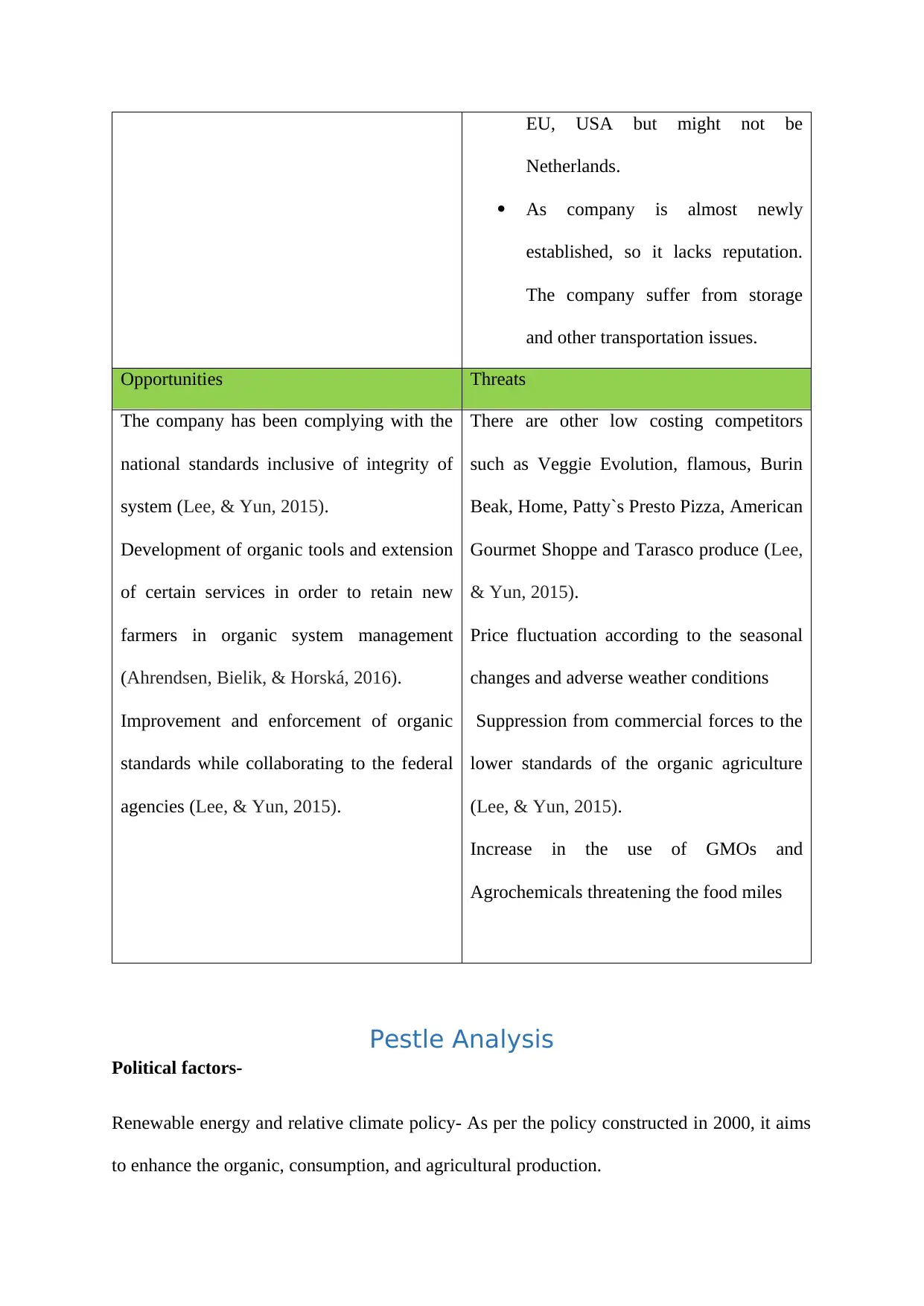
EU, USA but might not be
Netherlands.
As company is almost newly
established, so it lacks reputation.
The company suffer from storage
and other transportation issues.
Opportunities Threats
The company has been complying with the
national standards inclusive of integrity of
system (Lee, & Yun, 2015).
Development of organic tools and extension
of certain services in order to retain new
farmers in organic system management
(Ahrendsen, Bielik, & Horská, 2016).
Improvement and enforcement of organic
standards while collaborating to the federal
agencies (Lee, & Yun, 2015).
There are other low costing competitors
such as Veggie Evolution, flamous, Burin
Beak, Home, Patty`s Presto Pizza, American
Gourmet Shoppe and Tarasco produce (Lee,
& Yun, 2015).
Price fluctuation according to the seasonal
changes and adverse weather conditions
Suppression from commercial forces to the
lower standards of the organic agriculture
(Lee, & Yun, 2015).
Increase in the use of GMOs and
Agrochemicals threatening the food miles
Pestle Analysis
Political factors-
Renewable energy and relative climate policy- As per the policy constructed in 2000, it aims
to enhance the organic, consumption, and agricultural production.
Netherlands.
As company is almost newly
established, so it lacks reputation.
The company suffer from storage
and other transportation issues.
Opportunities Threats
The company has been complying with the
national standards inclusive of integrity of
system (Lee, & Yun, 2015).
Development of organic tools and extension
of certain services in order to retain new
farmers in organic system management
(Ahrendsen, Bielik, & Horská, 2016).
Improvement and enforcement of organic
standards while collaborating to the federal
agencies (Lee, & Yun, 2015).
There are other low costing competitors
such as Veggie Evolution, flamous, Burin
Beak, Home, Patty`s Presto Pizza, American
Gourmet Shoppe and Tarasco produce (Lee,
& Yun, 2015).
Price fluctuation according to the seasonal
changes and adverse weather conditions
Suppression from commercial forces to the
lower standards of the organic agriculture
(Lee, & Yun, 2015).
Increase in the use of GMOs and
Agrochemicals threatening the food miles
Pestle Analysis
Political factors-
Renewable energy and relative climate policy- As per the policy constructed in 2000, it aims
to enhance the organic, consumption, and agricultural production.
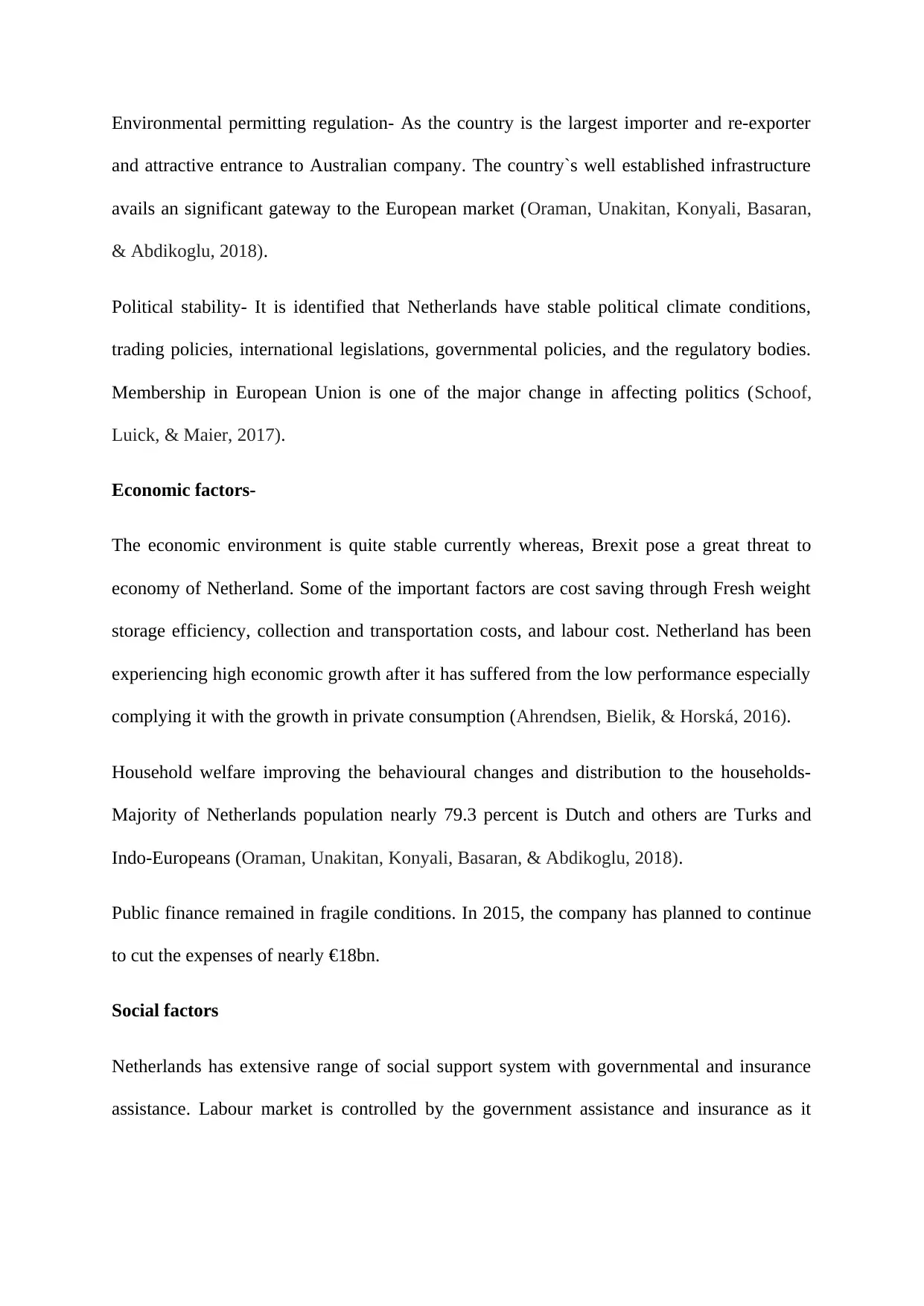
Environmental permitting regulation- As the country is the largest importer and re-exporter
and attractive entrance to Australian company. The country`s well established infrastructure
avails an significant gateway to the European market (Oraman, Unakitan, Konyali, Basaran,
& Abdikoglu, 2018).
Political stability- It is identified that Netherlands have stable political climate conditions,
trading policies, international legislations, governmental policies, and the regulatory bodies.
Membership in European Union is one of the major change in affecting politics (Schoof,
Luick, & Maier, 2017).
Economic factors-
The economic environment is quite stable currently whereas, Brexit pose a great threat to
economy of Netherland. Some of the important factors are cost saving through Fresh weight
storage efficiency, collection and transportation costs, and labour cost. Netherland has been
experiencing high economic growth after it has suffered from the low performance especially
complying it with the growth in private consumption (Ahrendsen, Bielik, & Horská, 2016).
Household welfare improving the behavioural changes and distribution to the households-
Majority of Netherlands population nearly 79.3 percent is Dutch and others are Turks and
Indo-Europeans (Oraman, Unakitan, Konyali, Basaran, & Abdikoglu, 2018).
Public finance remained in fragile conditions. In 2015, the company has planned to continue
to cut the expenses of nearly €18bn.
Social factors
Netherlands has extensive range of social support system with governmental and insurance
assistance. Labour market is controlled by the government assistance and insurance as it
and attractive entrance to Australian company. The country`s well established infrastructure
avails an significant gateway to the European market (Oraman, Unakitan, Konyali, Basaran,
& Abdikoglu, 2018).
Political stability- It is identified that Netherlands have stable political climate conditions,
trading policies, international legislations, governmental policies, and the regulatory bodies.
Membership in European Union is one of the major change in affecting politics (Schoof,
Luick, & Maier, 2017).
Economic factors-
The economic environment is quite stable currently whereas, Brexit pose a great threat to
economy of Netherland. Some of the important factors are cost saving through Fresh weight
storage efficiency, collection and transportation costs, and labour cost. Netherland has been
experiencing high economic growth after it has suffered from the low performance especially
complying it with the growth in private consumption (Ahrendsen, Bielik, & Horská, 2016).
Household welfare improving the behavioural changes and distribution to the households-
Majority of Netherlands population nearly 79.3 percent is Dutch and others are Turks and
Indo-Europeans (Oraman, Unakitan, Konyali, Basaran, & Abdikoglu, 2018).
Public finance remained in fragile conditions. In 2015, the company has planned to continue
to cut the expenses of nearly €18bn.
Social factors
Netherlands has extensive range of social support system with governmental and insurance
assistance. Labour market is controlled by the government assistance and insurance as it
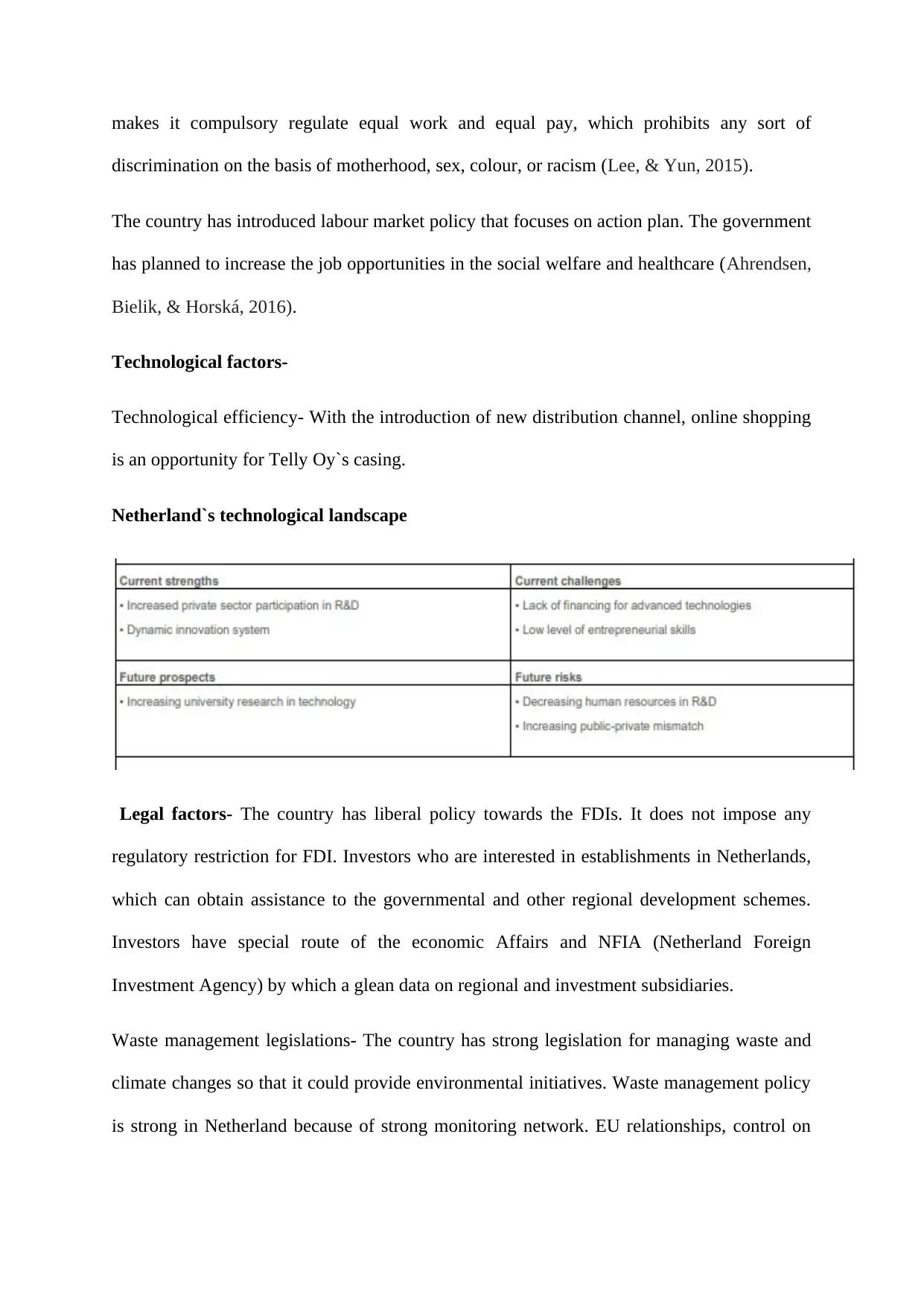
makes it compulsory regulate equal work and equal pay, which prohibits any sort of
discrimination on the basis of motherhood, sex, colour, or racism (Lee, & Yun, 2015).
The country has introduced labour market policy that focuses on action plan. The government
has planned to increase the job opportunities in the social welfare and healthcare (Ahrendsen,
Bielik, & Horská, 2016).
Technological factors-
Technological efficiency- With the introduction of new distribution channel, online shopping
is an opportunity for Telly Oy`s casing.
Netherland`s technological landscape
Legal factors- The country has liberal policy towards the FDIs. It does not impose any
regulatory restriction for FDI. Investors who are interested in establishments in Netherlands,
which can obtain assistance to the governmental and other regional development schemes.
Investors have special route of the economic Affairs and NFIA (Netherland Foreign
Investment Agency) by which a glean data on regional and investment subsidiaries.
Waste management legislations- The country has strong legislation for managing waste and
climate changes so that it could provide environmental initiatives. Waste management policy
is strong in Netherland because of strong monitoring network. EU relationships, control on
discrimination on the basis of motherhood, sex, colour, or racism (Lee, & Yun, 2015).
The country has introduced labour market policy that focuses on action plan. The government
has planned to increase the job opportunities in the social welfare and healthcare (Ahrendsen,
Bielik, & Horská, 2016).
Technological factors-
Technological efficiency- With the introduction of new distribution channel, online shopping
is an opportunity for Telly Oy`s casing.
Netherland`s technological landscape
Legal factors- The country has liberal policy towards the FDIs. It does not impose any
regulatory restriction for FDI. Investors who are interested in establishments in Netherlands,
which can obtain assistance to the governmental and other regional development schemes.
Investors have special route of the economic Affairs and NFIA (Netherland Foreign
Investment Agency) by which a glean data on regional and investment subsidiaries.
Waste management legislations- The country has strong legislation for managing waste and
climate changes so that it could provide environmental initiatives. Waste management policy
is strong in Netherland because of strong monitoring network. EU relationships, control on
Paraphrase This Document
Need a fresh take? Get an instant paraphrase of this document with our AI Paraphraser
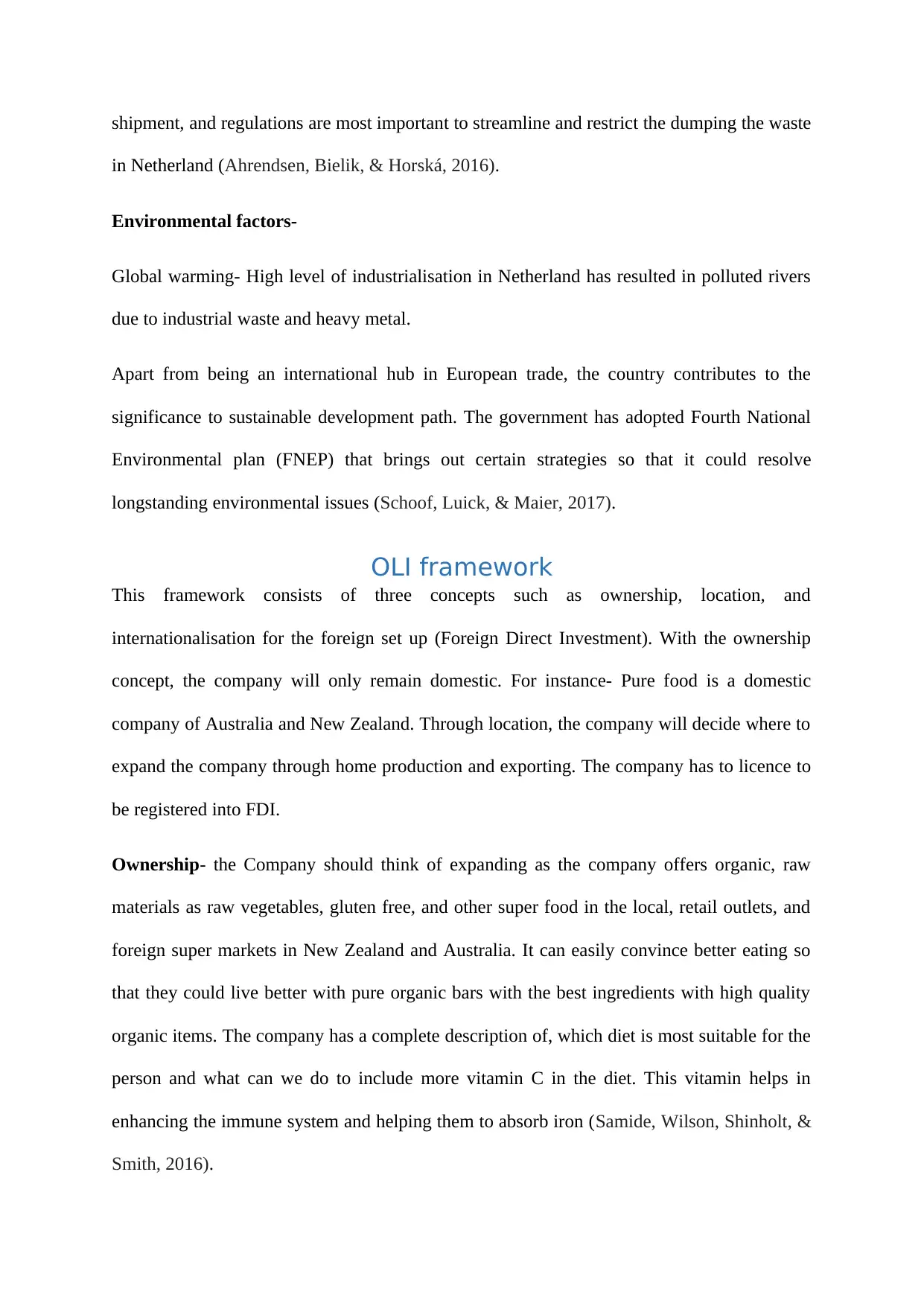
shipment, and regulations are most important to streamline and restrict the dumping the waste
in Netherland (Ahrendsen, Bielik, & Horská, 2016).
Environmental factors-
Global warming- High level of industrialisation in Netherland has resulted in polluted rivers
due to industrial waste and heavy metal.
Apart from being an international hub in European trade, the country contributes to the
significance to sustainable development path. The government has adopted Fourth National
Environmental plan (FNEP) that brings out certain strategies so that it could resolve
longstanding environmental issues (Schoof, Luick, & Maier, 2017).
OLI framework
This framework consists of three concepts such as ownership, location, and
internationalisation for the foreign set up (Foreign Direct Investment). With the ownership
concept, the company will only remain domestic. For instance- Pure food is a domestic
company of Australia and New Zealand. Through location, the company will decide where to
expand the company through home production and exporting. The company has to licence to
be registered into FDI.
Ownership- the Company should think of expanding as the company offers organic, raw
materials as raw vegetables, gluten free, and other super food in the local, retail outlets, and
foreign super markets in New Zealand and Australia. It can easily convince better eating so
that they could live better with pure organic bars with the best ingredients with high quality
organic items. The company has a complete description of, which diet is most suitable for the
person and what can we do to include more vitamin C in the diet. This vitamin helps in
enhancing the immune system and helping them to absorb iron (Samide, Wilson, Shinholt, &
Smith, 2016).
in Netherland (Ahrendsen, Bielik, & Horská, 2016).
Environmental factors-
Global warming- High level of industrialisation in Netherland has resulted in polluted rivers
due to industrial waste and heavy metal.
Apart from being an international hub in European trade, the country contributes to the
significance to sustainable development path. The government has adopted Fourth National
Environmental plan (FNEP) that brings out certain strategies so that it could resolve
longstanding environmental issues (Schoof, Luick, & Maier, 2017).
OLI framework
This framework consists of three concepts such as ownership, location, and
internationalisation for the foreign set up (Foreign Direct Investment). With the ownership
concept, the company will only remain domestic. For instance- Pure food is a domestic
company of Australia and New Zealand. Through location, the company will decide where to
expand the company through home production and exporting. The company has to licence to
be registered into FDI.
Ownership- the Company should think of expanding as the company offers organic, raw
materials as raw vegetables, gluten free, and other super food in the local, retail outlets, and
foreign super markets in New Zealand and Australia. It can easily convince better eating so
that they could live better with pure organic bars with the best ingredients with high quality
organic items. The company has a complete description of, which diet is most suitable for the
person and what can we do to include more vitamin C in the diet. This vitamin helps in
enhancing the immune system and helping them to absorb iron (Samide, Wilson, Shinholt, &
Smith, 2016).
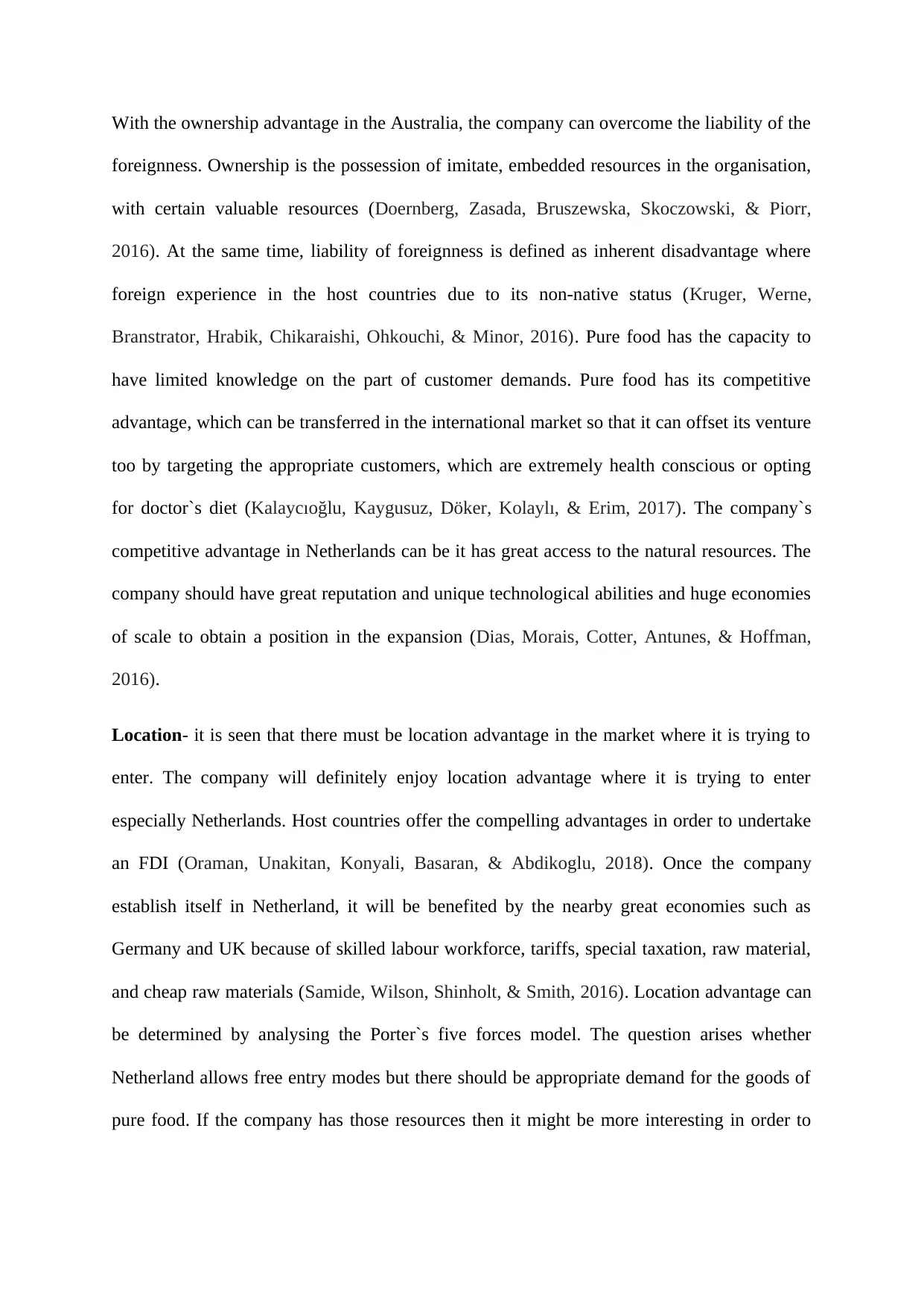
With the ownership advantage in the Australia, the company can overcome the liability of the
foreignness. Ownership is the possession of imitate, embedded resources in the organisation,
with certain valuable resources (Doernberg, Zasada, Bruszewska, Skoczowski, & Piorr,
2016). At the same time, liability of foreignness is defined as inherent disadvantage where
foreign experience in the host countries due to its non-native status (Kruger, Werne,
Branstrator, Hrabik, Chikaraishi, Ohkouchi, & Minor, 2016). Pure food has the capacity to
have limited knowledge on the part of customer demands. Pure food has its competitive
advantage, which can be transferred in the international market so that it can offset its venture
too by targeting the appropriate customers, which are extremely health conscious or opting
for doctor`s diet (Kalaycıoğlu, Kaygusuz, Döker, Kolaylı, & Erim, 2017). The company`s
competitive advantage in Netherlands can be it has great access to the natural resources. The
company should have great reputation and unique technological abilities and huge economies
of scale to obtain a position in the expansion (Dias, Morais, Cotter, Antunes, & Hoffman,
2016).
Location- it is seen that there must be location advantage in the market where it is trying to
enter. The company will definitely enjoy location advantage where it is trying to enter
especially Netherlands. Host countries offer the compelling advantages in order to undertake
an FDI (Oraman, Unakitan, Konyali, Basaran, & Abdikoglu, 2018). Once the company
establish itself in Netherland, it will be benefited by the nearby great economies such as
Germany and UK because of skilled labour workforce, tariffs, special taxation, raw material,
and cheap raw materials (Samide, Wilson, Shinholt, & Smith, 2016). Location advantage can
be determined by analysing the Porter`s five forces model. The question arises whether
Netherland allows free entry modes but there should be appropriate demand for the goods of
pure food. If the company has those resources then it might be more interesting in order to
foreignness. Ownership is the possession of imitate, embedded resources in the organisation,
with certain valuable resources (Doernberg, Zasada, Bruszewska, Skoczowski, & Piorr,
2016). At the same time, liability of foreignness is defined as inherent disadvantage where
foreign experience in the host countries due to its non-native status (Kruger, Werne,
Branstrator, Hrabik, Chikaraishi, Ohkouchi, & Minor, 2016). Pure food has the capacity to
have limited knowledge on the part of customer demands. Pure food has its competitive
advantage, which can be transferred in the international market so that it can offset its venture
too by targeting the appropriate customers, which are extremely health conscious or opting
for doctor`s diet (Kalaycıoğlu, Kaygusuz, Döker, Kolaylı, & Erim, 2017). The company`s
competitive advantage in Netherlands can be it has great access to the natural resources. The
company should have great reputation and unique technological abilities and huge economies
of scale to obtain a position in the expansion (Dias, Morais, Cotter, Antunes, & Hoffman,
2016).
Location- it is seen that there must be location advantage in the market where it is trying to
enter. The company will definitely enjoy location advantage where it is trying to enter
especially Netherlands. Host countries offer the compelling advantages in order to undertake
an FDI (Oraman, Unakitan, Konyali, Basaran, & Abdikoglu, 2018). Once the company
establish itself in Netherland, it will be benefited by the nearby great economies such as
Germany and UK because of skilled labour workforce, tariffs, special taxation, raw material,
and cheap raw materials (Samide, Wilson, Shinholt, & Smith, 2016). Location advantage can
be determined by analysing the Porter`s five forces model. The question arises whether
Netherland allows free entry modes but there should be appropriate demand for the goods of
pure food. If the company has those resources then it might be more interesting in order to
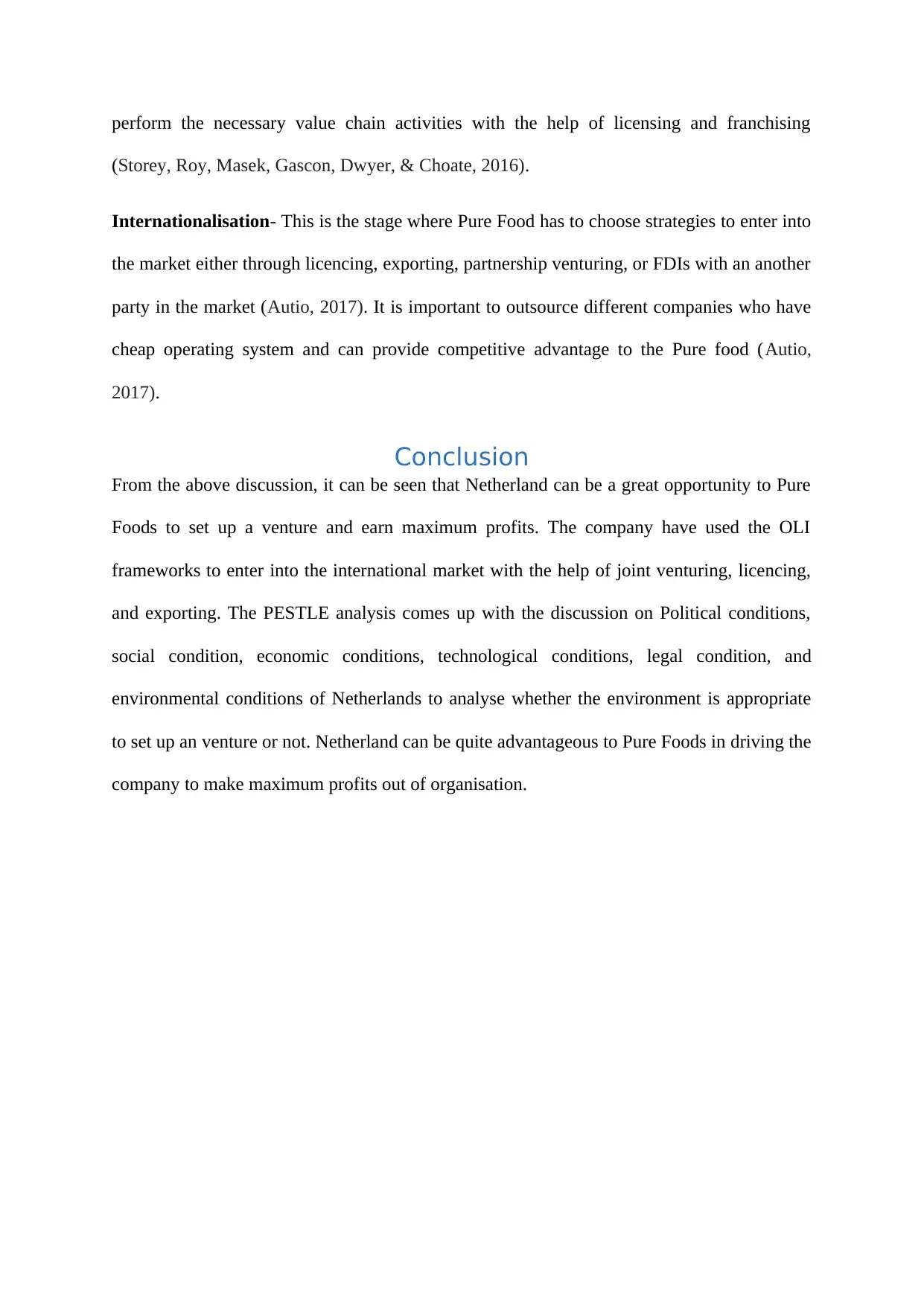
perform the necessary value chain activities with the help of licensing and franchising
(Storey, Roy, Masek, Gascon, Dwyer, & Choate, 2016).
Internationalisation- This is the stage where Pure Food has to choose strategies to enter into
the market either through licencing, exporting, partnership venturing, or FDIs with an another
party in the market (Autio, 2017). It is important to outsource different companies who have
cheap operating system and can provide competitive advantage to the Pure food (Autio,
2017).
Conclusion
From the above discussion, it can be seen that Netherland can be a great opportunity to Pure
Foods to set up a venture and earn maximum profits. The company have used the OLI
frameworks to enter into the international market with the help of joint venturing, licencing,
and exporting. The PESTLE analysis comes up with the discussion on Political conditions,
social condition, economic conditions, technological conditions, legal condition, and
environmental conditions of Netherlands to analyse whether the environment is appropriate
to set up an venture or not. Netherland can be quite advantageous to Pure Foods in driving the
company to make maximum profits out of organisation.
(Storey, Roy, Masek, Gascon, Dwyer, & Choate, 2016).
Internationalisation- This is the stage where Pure Food has to choose strategies to enter into
the market either through licencing, exporting, partnership venturing, or FDIs with an another
party in the market (Autio, 2017). It is important to outsource different companies who have
cheap operating system and can provide competitive advantage to the Pure food (Autio,
2017).
Conclusion
From the above discussion, it can be seen that Netherland can be a great opportunity to Pure
Foods to set up a venture and earn maximum profits. The company have used the OLI
frameworks to enter into the international market with the help of joint venturing, licencing,
and exporting. The PESTLE analysis comes up with the discussion on Political conditions,
social condition, economic conditions, technological conditions, legal condition, and
environmental conditions of Netherlands to analyse whether the environment is appropriate
to set up an venture or not. Netherland can be quite advantageous to Pure Foods in driving the
company to make maximum profits out of organisation.
Secure Best Marks with AI Grader
Need help grading? Try our AI Grader for instant feedback on your assignments.
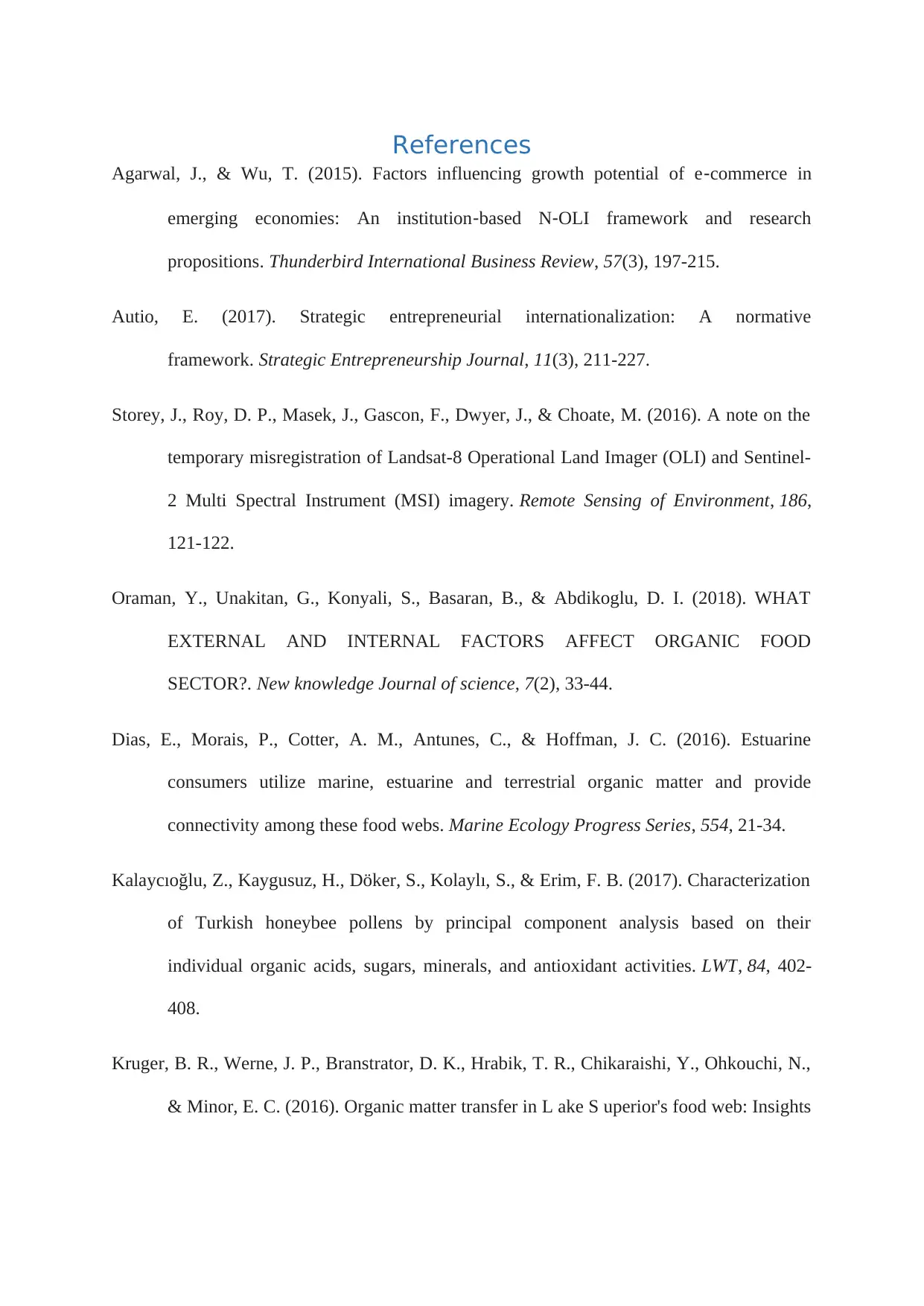
References
Agarwal, J., & Wu, T. (2015). Factors influencing growth potential of e‐commerce in
emerging economies: An institution‐based N‐OLI framework and research
propositions. Thunderbird International Business Review, 57(3), 197-215.
Autio, E. (2017). Strategic entrepreneurial internationalization: A normative
framework. Strategic Entrepreneurship Journal, 11(3), 211-227.
Storey, J., Roy, D. P., Masek, J., Gascon, F., Dwyer, J., & Choate, M. (2016). A note on the
temporary misregistration of Landsat-8 Operational Land Imager (OLI) and Sentinel-
2 Multi Spectral Instrument (MSI) imagery. Remote Sensing of Environment, 186,
121-122.
Oraman, Y., Unakitan, G., Konyali, S., Basaran, B., & Abdikoglu, D. I. (2018). WHAT
EXTERNAL AND INTERNAL FACTORS AFFECT ORGANIC FOOD
SECTOR?. New knowledge Journal of science, 7(2), 33-44.
Dias, E., Morais, P., Cotter, A. M., Antunes, C., & Hoffman, J. C. (2016). Estuarine
consumers utilize marine, estuarine and terrestrial organic matter and provide
connectivity among these food webs. Marine Ecology Progress Series, 554, 21-34.
Kalaycıoğlu, Z., Kaygusuz, H., Döker, S., Kolaylı, S., & Erim, F. B. (2017). Characterization
of Turkish honeybee pollens by principal component analysis based on their
individual organic acids, sugars, minerals, and antioxidant activities. LWT, 84, 402-
408.
Kruger, B. R., Werne, J. P., Branstrator, D. K., Hrabik, T. R., Chikaraishi, Y., Ohkouchi, N.,
& Minor, E. C. (2016). Organic matter transfer in L ake S uperior's food web: Insights
Agarwal, J., & Wu, T. (2015). Factors influencing growth potential of e‐commerce in
emerging economies: An institution‐based N‐OLI framework and research
propositions. Thunderbird International Business Review, 57(3), 197-215.
Autio, E. (2017). Strategic entrepreneurial internationalization: A normative
framework. Strategic Entrepreneurship Journal, 11(3), 211-227.
Storey, J., Roy, D. P., Masek, J., Gascon, F., Dwyer, J., & Choate, M. (2016). A note on the
temporary misregistration of Landsat-8 Operational Land Imager (OLI) and Sentinel-
2 Multi Spectral Instrument (MSI) imagery. Remote Sensing of Environment, 186,
121-122.
Oraman, Y., Unakitan, G., Konyali, S., Basaran, B., & Abdikoglu, D. I. (2018). WHAT
EXTERNAL AND INTERNAL FACTORS AFFECT ORGANIC FOOD
SECTOR?. New knowledge Journal of science, 7(2), 33-44.
Dias, E., Morais, P., Cotter, A. M., Antunes, C., & Hoffman, J. C. (2016). Estuarine
consumers utilize marine, estuarine and terrestrial organic matter and provide
connectivity among these food webs. Marine Ecology Progress Series, 554, 21-34.
Kalaycıoğlu, Z., Kaygusuz, H., Döker, S., Kolaylı, S., & Erim, F. B. (2017). Characterization
of Turkish honeybee pollens by principal component analysis based on their
individual organic acids, sugars, minerals, and antioxidant activities. LWT, 84, 402-
408.
Kruger, B. R., Werne, J. P., Branstrator, D. K., Hrabik, T. R., Chikaraishi, Y., Ohkouchi, N.,
& Minor, E. C. (2016). Organic matter transfer in L ake S uperior's food web: Insights
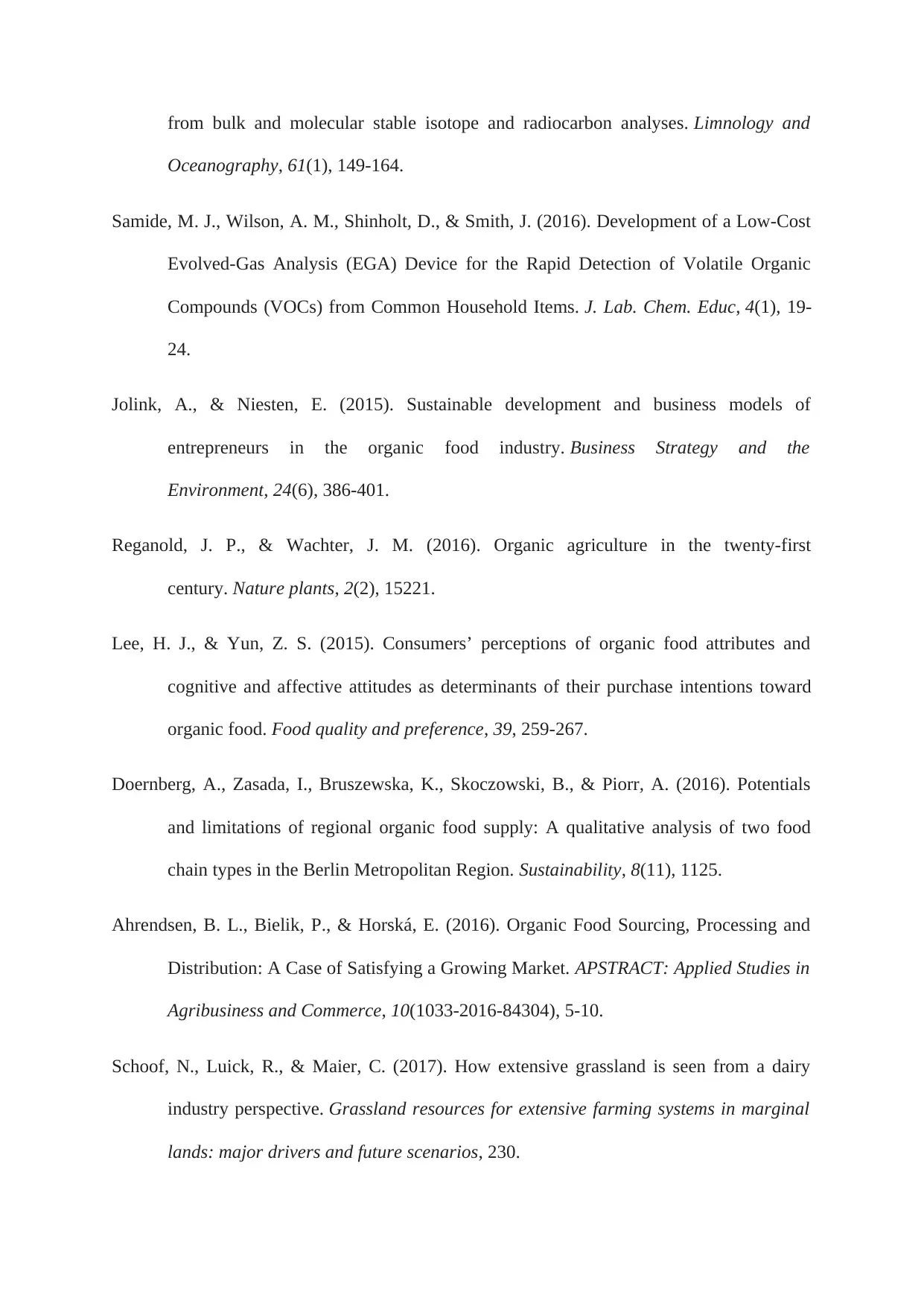
from bulk and molecular stable isotope and radiocarbon analyses. Limnology and
Oceanography, 61(1), 149-164.
Samide, M. J., Wilson, A. M., Shinholt, D., & Smith, J. (2016). Development of a Low-Cost
Evolved-Gas Analysis (EGA) Device for the Rapid Detection of Volatile Organic
Compounds (VOCs) from Common Household Items. J. Lab. Chem. Educ, 4(1), 19-
24.
Jolink, A., & Niesten, E. (2015). Sustainable development and business models of
entrepreneurs in the organic food industry. Business Strategy and the
Environment, 24(6), 386-401.
Reganold, J. P., & Wachter, J. M. (2016). Organic agriculture in the twenty-first
century. Nature plants, 2(2), 15221.
Lee, H. J., & Yun, Z. S. (2015). Consumers’ perceptions of organic food attributes and
cognitive and affective attitudes as determinants of their purchase intentions toward
organic food. Food quality and preference, 39, 259-267.
Doernberg, A., Zasada, I., Bruszewska, K., Skoczowski, B., & Piorr, A. (2016). Potentials
and limitations of regional organic food supply: A qualitative analysis of two food
chain types in the Berlin Metropolitan Region. Sustainability, 8(11), 1125.
Ahrendsen, B. L., Bielik, P., & Horská, E. (2016). Organic Food Sourcing, Processing and
Distribution: A Case of Satisfying a Growing Market. APSTRACT: Applied Studies in
Agribusiness and Commerce, 10(1033-2016-84304), 5-10.
Schoof, N., Luick, R., & Maier, C. (2017). How extensive grassland is seen from a dairy
industry perspective. Grassland resources for extensive farming systems in marginal
lands: major drivers and future scenarios, 230.
Oceanography, 61(1), 149-164.
Samide, M. J., Wilson, A. M., Shinholt, D., & Smith, J. (2016). Development of a Low-Cost
Evolved-Gas Analysis (EGA) Device for the Rapid Detection of Volatile Organic
Compounds (VOCs) from Common Household Items. J. Lab. Chem. Educ, 4(1), 19-
24.
Jolink, A., & Niesten, E. (2015). Sustainable development and business models of
entrepreneurs in the organic food industry. Business Strategy and the
Environment, 24(6), 386-401.
Reganold, J. P., & Wachter, J. M. (2016). Organic agriculture in the twenty-first
century. Nature plants, 2(2), 15221.
Lee, H. J., & Yun, Z. S. (2015). Consumers’ perceptions of organic food attributes and
cognitive and affective attitudes as determinants of their purchase intentions toward
organic food. Food quality and preference, 39, 259-267.
Doernberg, A., Zasada, I., Bruszewska, K., Skoczowski, B., & Piorr, A. (2016). Potentials
and limitations of regional organic food supply: A qualitative analysis of two food
chain types in the Berlin Metropolitan Region. Sustainability, 8(11), 1125.
Ahrendsen, B. L., Bielik, P., & Horská, E. (2016). Organic Food Sourcing, Processing and
Distribution: A Case of Satisfying a Growing Market. APSTRACT: Applied Studies in
Agribusiness and Commerce, 10(1033-2016-84304), 5-10.
Schoof, N., Luick, R., & Maier, C. (2017). How extensive grassland is seen from a dairy
industry perspective. Grassland resources for extensive farming systems in marginal
lands: major drivers and future scenarios, 230.
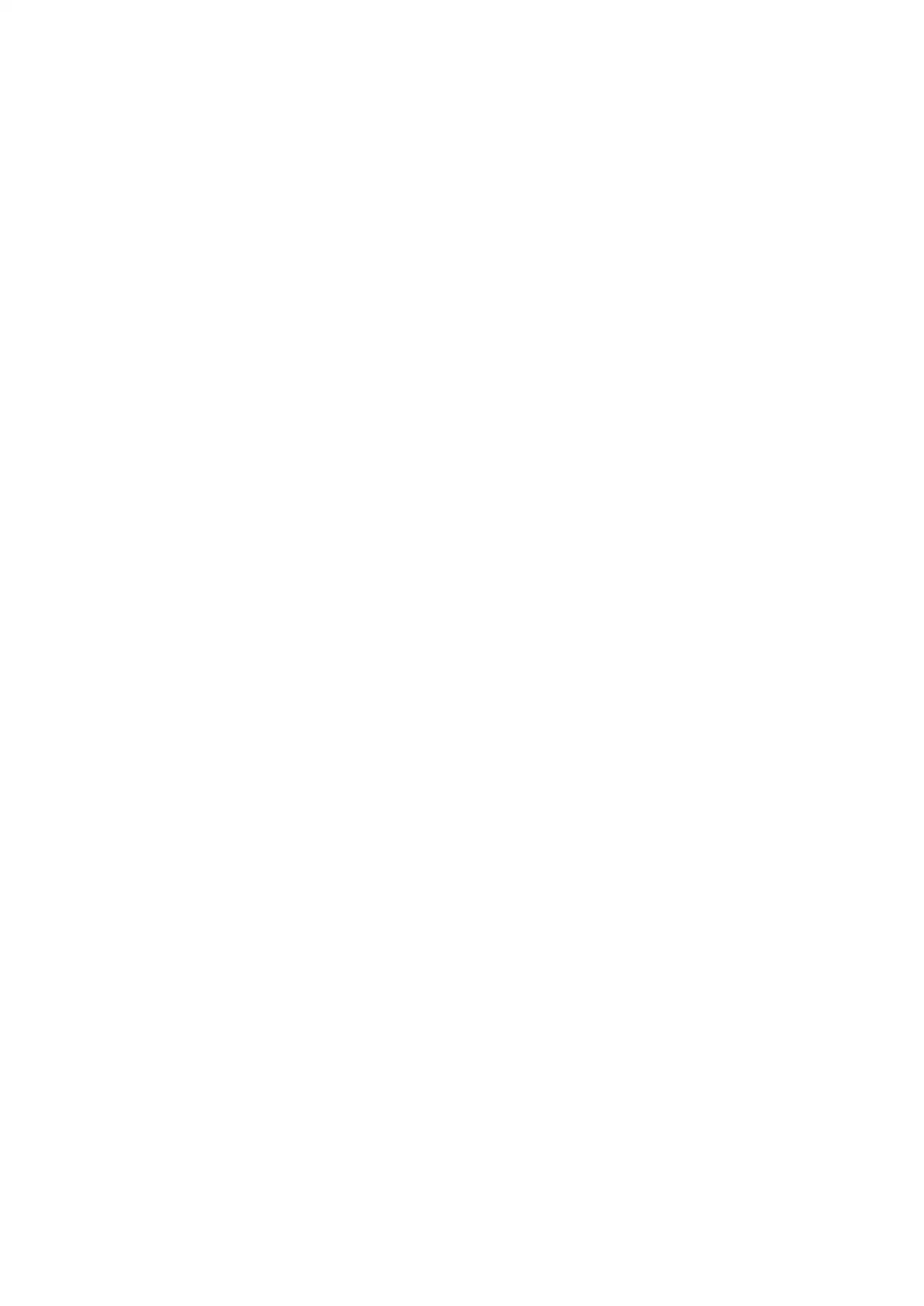
1 out of 13
Your All-in-One AI-Powered Toolkit for Academic Success.
+13062052269
info@desklib.com
Available 24*7 on WhatsApp / Email
![[object Object]](/_next/static/media/star-bottom.7253800d.svg)
Unlock your academic potential
© 2024 | Zucol Services PVT LTD | All rights reserved.